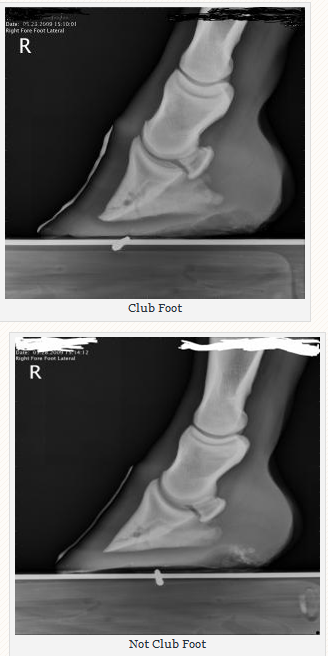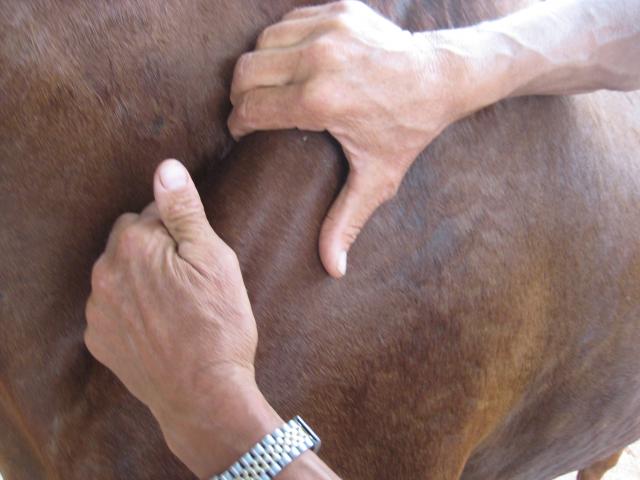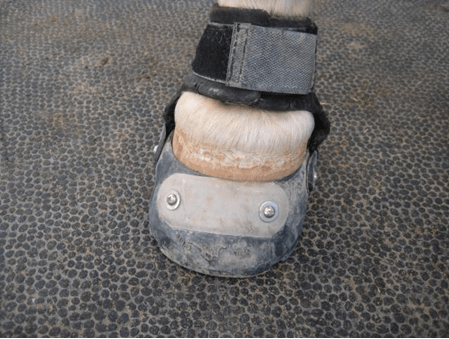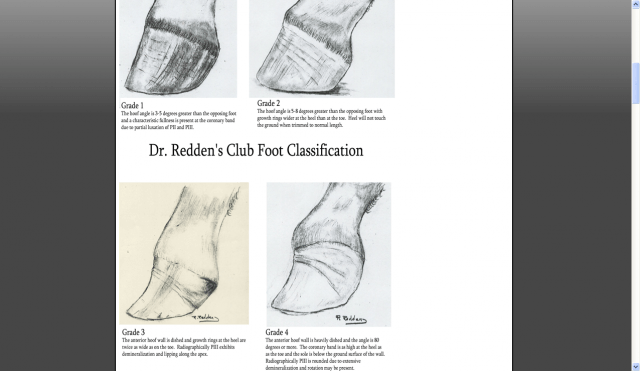Many articles have been written about club ‘footed’ horses. Actually, horse do not have ‘feet’, dogs and humans do, but horses have hooves. Therefore the term ‘barefoot’, as much as it is in common use now, really is a misnomer. When we ride without hoof protection, we ride ‘bare hoof’. Ah well, a pet peeve of mine!
Today, I want to give an overview for the reasons club hooves occur and how we can manage and improve on the situation.
Dr. Redden’s classification of club hooves (photo above).
While Grade 3 and 4 are extreme and the horses are most likely very lame, Grade 2 and 3 are not that uncommon. I will mostly focus on these two grades.
How do these club hooves happen or develop?

First we do have the genetic club hoof, the foal is born with it, where P3 is out of alignment with P2 and P1 and displays a steeper angle. This can only be observed on a radiograph.
Clearly visible on the first image: the dished dorsal hoof wall and P3 is rotated downward and has a steeper angle compared to P1 and P2. These genetic downward rotation is very hard to overcome and correct.
Other causes for club hooves:
– Excessive pawing and consequently deep flexor tendon shortening
Already in the 1,800s, German farriers observed foals developing “Stelzhuf” during dry years or when kept in stalls and pawing for hours. The unpressured heels grew excessively and the toes developed dishes dorsally. Allowing plenty of pasture and space to roam, will help fixing this unhealthy habit in foals, that sometimes is also observable in adult horses.
–Epiphysitis
Occurring in young foals, when the long bones grow faster than the tendons. The tendons cannot keep up with that growth, thus getting very tight and not allowing to flex when the foal tries to step forward. Less weight over the heels will make the heel grow excessively and the deep digital flexor tendon is pulling the wings of P3 upward, thus rotating the tip of P3 downward. Often caused by too much protein intake. This is a case where your veterinarian can advise you best.
–Suprascapular nerve damage
The muscles that hold the scapula close to the body have a suprascapular nerve. Sometimes, when the horses leg gives out when bearing weight, this nerve can get damaged, thus impeding proper muscle movements. The stride is shortened, thus again, placing more weight over the toe and less pressure over the heel area on the affected side. Club hoof in the development. Veterinarians call this situation often ‘Sweeney’.
–Muscle injuries and adhesions
The two muscles holding the scapula in place can get injured through jumping, riding fast or in a trot through dips in the trail, rough play in the pasture or by pinching and poorly fitted saddles. When these muscles are injured, often the horse is unwilling to extend the affected shoulder and leg, again resulting in shortened strides and toe landings with decreased heel pressure, resulting in the excessive heel growth.
–High/Low syndrome
Grazing horses, especially long legged horses with short necks can develop an habitual club hoof. The same hoof will always be forward and the other back. The back hoof will get pressure on the toe, developing a dorsal dish, the heels are mostly unpressured, growing faster than the toe.

This horse is habitually placing the right front back when eating/grazing close to the ground, thus developing a grade one (by Dr. Redden classification) club hoof.
Correctional measurements: feed higher above the ground.
All these conditions can get improved through careful stretching forward of the affected limb and massaging the groove between the body and the scapula. Below some images of massaging this area.

Here I start to gently massage and opening up the muscles around the scapula. Everything is still tight.

Slowly getting deeper into the fissure.

I switch using the side of my hand to open the space.

Further opening the space by applying more pressure with my sliding hand.


By now, more than half my hand disappears beneath the scapula. I keep opening the gap more and more, till the adhesions are loosened and the muscles supple (3 to 5 minutes will often be sufficient).
Be gentle, watch the body language of the horse: if she leans into you, licks the lips, moves the head towards you, it will feel good and you are getting results. Massage oil will help opening the scapula and relax your horse.
Training considerations:
When training a horse with a club hoof, make sure the saddle fits properly without pinching the shoulders. Focus on balanced riding. When posting in a trot, post on the clubbed side most of the time. When cantering, lead with the clubbed side. Work cantering circles with the club hoof on the inside, walk and trot circles with the clubbed hoof on the outside.
Trimming considerations:
Guard against the temptation to just cut the heels down to match the ‘normal’ side. When over trimming into live sole in the heel area, the hoof will respond quickly by growing even more sole thickness back, and that rather quickly. Furthermore, by thinning the sole, the lateral cartilages sink downward, thus raising the heels from within. By lowering the heels too much, the deep flexor tendon can get stretched and stressed too much, causing injury.
Mapping the sole will tell you how much to trim. Exfoliate the dead sole just to the live sole, but no further. No matter how high the heel is and how clubby the hoof looks. Leave the hoof wall and bars about 1/16 to 1/8 of an inch longer than the heel. Keep the sole callous area on the toe, bevel the hoof wall and allow the flare to grow out. Trim a little often, in a one or two week interval. Just remove the chalky dead sole and shorten the heels to the above mentioned length. With proper management, care, massage, training and feeding regimen and riding bare, the club hoof might just normalize surprisingly fast.
Below an example of a clubby hoof and the change that occurred within 5 months:

Notice the big dish on this habitual club hoof.

5 months later, the dish is greatly diminished, (notice that I did not rasp the dorsal hoof wall at all for this picture), the hoof expanded and is now almost the same size as the ‘normal’ left hoof.

These are visible results, that proper trimming and management can succeed.
Protective Horse Boot considerations:
Barefoot Trimming, Natural Hoof Care, Bare hoof riding will all contribute to success. When selecting Easyboot Gloves, it is advisable to use power straps, especially if you have any dorsal hoof wall flares present.

This Easyboot Glove with Power strap was adjusted to the first image of the flared hoof photographed above. We do see a good and close fit on the hoof wall.
A few layers of athletic tape worked in this case as well.

When trotting horses with one club hoof, inevitably the sound of the hooves hitting the ground will differ from left to right. The clubbed hoofed leg will also not extend as far forward as the normal leg. This causes the trot to be somewhat uneven. Endurance riders know the importance of a sound horse that leaves no question mark. Even more an incentive to manage and improve the club hooves.
Your Bootmeister
From the Global Endurance Training Center in Moab





